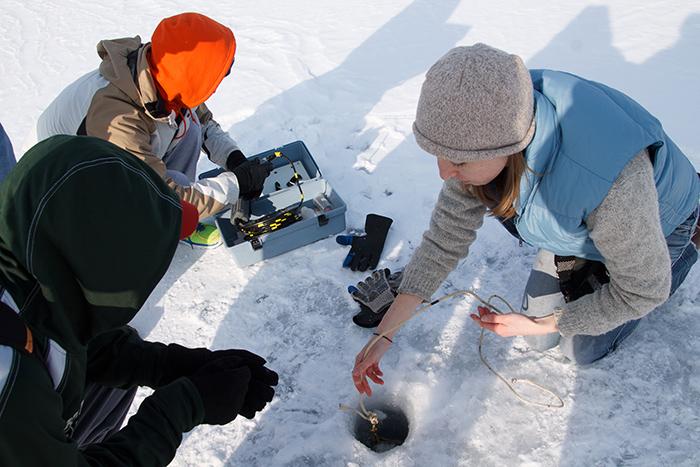Breaking the Ice

Assistant Professor of Environmental Studies Kristin Strock shows students how to take lake samples through ice to determine the impact of temperature on aquatic ecosystems. Photo by Kathryn Davison '16.
Limnology students get hands-on lesson on aquatic ecosystems
For students in Kristin Strock's Limnology: The Study of Lakes course, this winter's heavy dose of snow and ice was much more than something to trudge through on their way to class. It was something to probe hands-on to learn how lakes respond to changing temperatures more deeply than they could from any lecture or textbook.
To help her students understand the influence of environmental change on aquatic ecosystems, Strock took them to nearby Laurel Lake in Pine Grove Furnace State Park. There, they collected samples of lake water, algae and plankton, which they explored more deeply back in the lab to gain a better understanding of the lake's thermal habitat zones during the winter.
"Walking out on a frozen lake and learning how to break holes in the ice is an experience that you can't get in the classroom," said Jared Ginsburg '16. "There is no better way to learn the process of collecting data than doing it yourself and having a professional like Professor Strock show us proper techniques. This type of experience to really get a hands-on look at how research is started is invaluable for my future."
A warmer return
As the weather warms, Strock will bring the students back to the state park to see how the lake's biological community responds to the change in temperature. The field experience will culminate in a group research project challenging students to pose their own research questions, collect data and interpret their results. The experience, Strock explained, helps students better understand the important connections among lake ecosystems, their watersheds, and the atmosphere, all of which inform how freshwater ecosystems are managed and protected.
"Based on concepts they learn in class, students could predict what the condition of Laurel Lake would be under the ice, and in the laboratory they even modeled how lakes might change from winter to spring," she said. "But it wasn’t until we got out there and students could test their predictions by collecting their own data that they truly could put what they learned into practice. As we stood on the ice, I got to listen to students debate what an inverse temperature profile might mean for oxygen availability or how prolonged ice cover might influence plankton dynamics in the spring. It sparked a whole new set of conversations that we brought back to the classroom."
Active learning
Representative of a commitment to active learning that runs throughout Dickinson's curriculum, the way Strock's course combines field research and classroom discussion doesn't just help students understand scientific concepts. It empowers them to tackle tomorrow's challenges.
"The class is not only providing me with information on the topic but also teaching me to use analytical skills to answer tough questions that lake managers are facing today," said Elizabeth de la Reguera '14. "We learn about different mechanisms in lakes, and then Kristin poses questions on how we would attempt to fix the problem. This way of teaching allows us to think critically and practically and helps us come up with solutions."
Learn More
Environmental Studies & Environmental Science
Published March 20, 2014